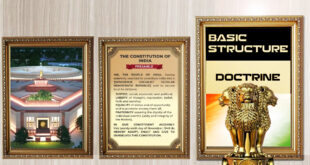The passage of the Women’s Reservation Bill in the Lok Sabha almost three decades after it was first tabled in Parliament is a welcome move that can finally shatter a political glass ceiling.
- The Women’s Reservation Bill (WRB) was passed by the Lok Sabha with a two-thirds majority.
- The bill seeks to reserve one-third of all seats for women in the Lok Sabha and state legislative assemblies.
- The bill was passed with 454 members supporting it and two members opposing it.
- The bill has been remained in place for 15
 years from the day of its implementation. Parliament can extend the duration if required. • The Bill also mandates that as nearly as one-third of the seats reserved for Scheduled Castes and Scheduled Tribes will be set aside for women.
years from the day of its implementation. Parliament can extend the duration if required. • The Bill also mandates that as nearly as one-third of the seats reserved for Scheduled Castes and Scheduled Tribes will be set aside for women.
The bill is considered important because:
- It adheres to constitutional principles and takes caste diversity into consideration.
- Without a gender quota, women’s representation would remain minimal.
Problems in the bill:
- The bill has been in the works for 27 years.
- The bill to be implemented immediately rather than by 2029. • Wanted a quota for OBCs and Muslims within the general quota
Cauvery Dispute
The Supreme Court on Thursday refused to interfere with the Cauvery Water Management Authority’s (CWMA) direction to Karnataka to release 5,000 cusecs of water per day for 15 days to neighbouring Tamil Nadu.
Cauvery (Kaveri):
- Cauvery, the ‘Dakshina Ganga’ or the Ganges of the south, and the fourth largest river of southern India has been the economic backbone of the states through which it flows, making its impact felt most strongly in Karnataka and Tamil Nadu.
- In these two states, the river is almost the Mother Goddess, entwined with the identity of the people there.
- It is celebrated in music and literature and sung praises of in prayer and legends.
- Yet this same holy river has been the bone of contention between the two states for decades.
- The contest for Cauvery between what is modern day Tamil Nadu and Karnataka can be traced back to the 11th century AD. • It is believed that Chikkadeva Wodeyar of Mysore attempted to stop the flow of Cauvery into Tamil regions to settle scores with Chokkanath Naik of Madurai kingdom.
Dispute:
- The Cauvery water dispute is a conflict between the Indian states of Tamil Nadu and Karnataka over the sharing of the Cauvery River.
- The dispute dates back to 1807 when the Mysore state began development projects
 on the river, which the Madras government disapproved of.
on the river, which the Madras government disapproved of. - The two governments signed agreements in 1892 and 1924.
- The dispute arose because the Mettur dam in Tamil Nadu can only be filled if water is released from the Krishna Raja Sagara dam in Karnataka.
- The water in the Mettur dam is used for crops in the delta region of Tamil Nadu.
- The water in the Krishna Raja Sagara dam is used for irrigation in Karnataka and to meet the water needs of Bengaluru.
- In 1997, the Attorney General of India made a statement in the Supreme Court that the Union of India would prepare a scheme to implement the Interim Award of the Tribunal.
British government favoured Madras:
- The relationship shared between Madras presidency and Mysore state was that of a ‘sovereign power and a feudal unit.’ “Because of these reasons, the then British government favoured Madras,”
- When Madras presidency disapproved of Mysore’s irrigation plans on the Cauvery in 1807, and the two states could not come to a mutual agreement, the matter had to be taken by the government of India which was then in British hands.
- Through the intervention of the British government, the General Agreement of 1892 was signed between the two states.
- The agreement entitled, “Rules defining the limits within which no new irrigation works are to be constructed by Mysore State without previous reference to Madras government,” laid out six rules of negotiation between the two states regarding Cauvery water.
Other News
| ICMR nod to conduct Truenat test to detect Nipah | • incubation period is 21 days
• Kerala has been accorded sanction by the Indian Council for Medical Research (ICMR) to use Truenat test to diagnose Nipah. • Hospitals with BSL 2 level labs can perform the test. |
| Kurmis call off stir after Calcutta HC calls it illegal and unconstitutional | • Kurmi tribe is found in Jharkhand, West Bengal and Odisha |
| • seeking Scheduled Tribe (ST) status for the community
• demand to include Kurmali language in the eighth schedule of the Constitution. |
|
| Study throws light on how gravitational instabilities affect evolution of galaxies | • Study conducted by Indian Institute of Astrophysics
• understand how gravitational instabilities are connected to galaxy evolution. • sample of 175 galaxies taken from the Spitzer Photometry and Accurate Rotation Curves (SPARC) database • spiral galaxies exhibit a higher median star formation rate, lower stability, lower gas fraction, and a smaller timescale for the growth of gravitational instabilities • trace the role of dark matter in regulating the stability levels of the galaxies and understand if stars and gas can self regulate the stability levels |
| What is the tussle between the Central government and the Delhi Waqf Board? | Delhi Waqf Board
• State level statuary body • Established under Waqf Act, 1954 of Delhi Government • exercises control over mosques, graveyards and religious waqfs. Central Waqf Council • statutory body under the Ministry of Minority Affairs • set up in 1964 by the Waqf Act, 1954 • Advisory Body to the Central Government on matters concerning the working of the Waqf Boards |
 Chinmaya IAS Academy – Current Affairs Chinmaya IAS Academy – Current Affairs
Chinmaya IAS Academy – Current Affairs Chinmaya IAS Academy – Current Affairs



